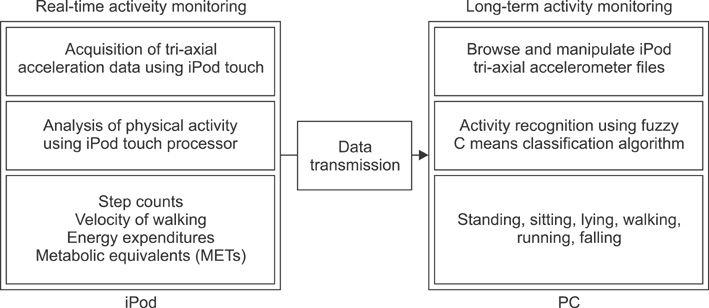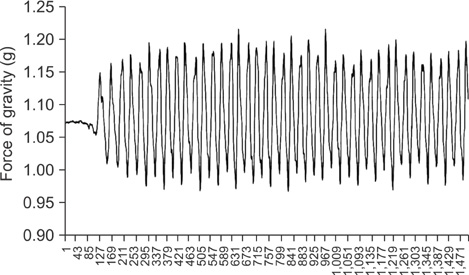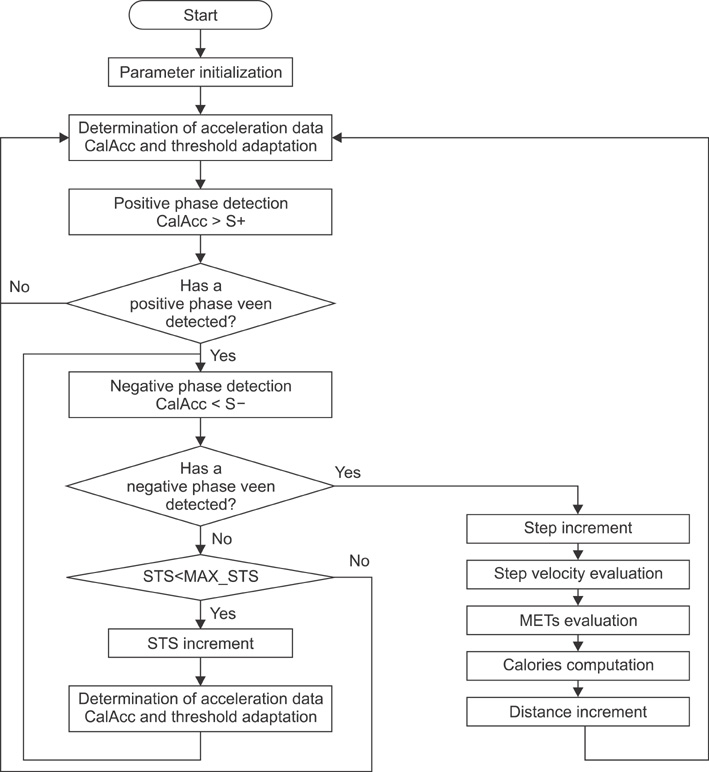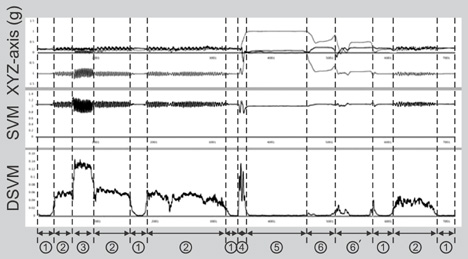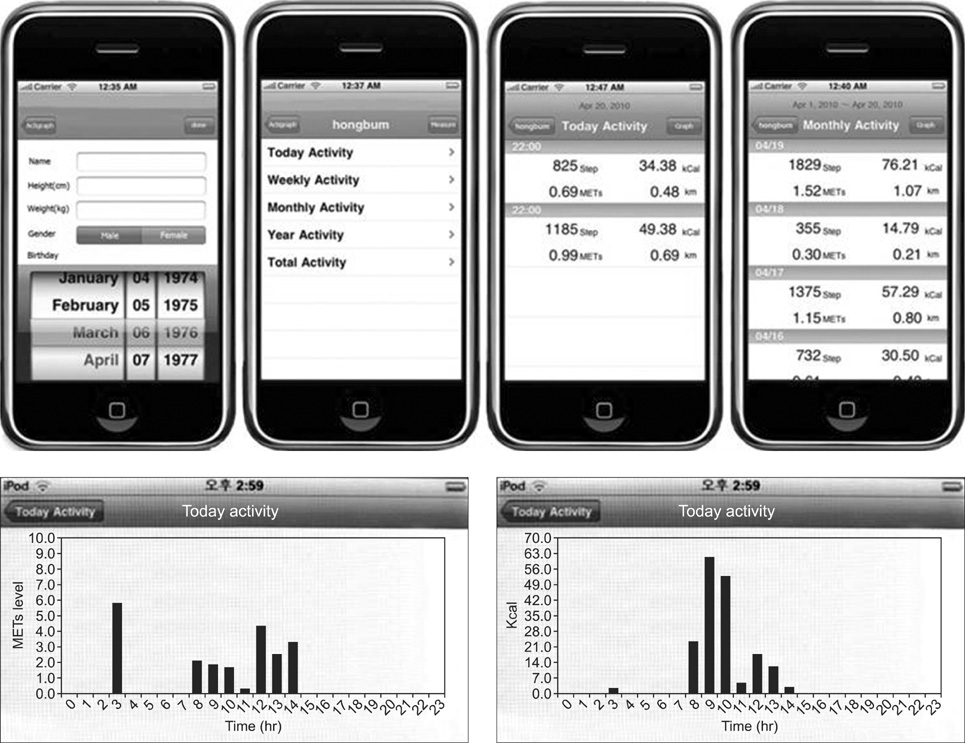Healthc Inform Res.
2011 Mar;17(1):76-86. 10.4258/hir.2011.17.1.76.
Integrated Solution for Physical Activity Monitoring Based on Mobile Phone and PC
- Affiliations
-
- 1Department of Medical Engineering, Yonsei University College of Medicine, Seoul, Korea. sunkyoo@yuhs.ac
- 2Institute for Health Promotion, Yonsei University Graduate School of Public Health, Seoul, Korea.
- 3Brain Korea 21 for the College of Medical Science, Yonsei University, Seoul, Korea.
- KMID: 2166598
- DOI: http://doi.org/10.4258/hir.2011.17.1.76
Abstract
OBJECTIVES
This study is part of the ongoing development of treatment methods for metabolic syndrome (MS) project, which involves monitoring daily physical activity. In this study, we have focused on detecting walking activity from subjects which includes many other physical activities such as standing, sitting, lying, walking, running, and falling. Specially, we implemented an integrated solution for various physical activities monitoring using a mobile phone and PC.
METHODS
We put the iPod touch has built in a tri-axial accelerometer on the waist of the subjects, and measured change in acceleration signal according to change in ambulatory movement and physical activities. First, we developed of programs that are aware of step counts, velocity of walking, energy consumptions, and metabolic equivalents based on iPod. Second, we have developed the activity recognition program based on PC. iPod synchronization with PC to transmit measured data using iPhoneBrowser program. Using the implemented system, we analyzed change in acceleration signal according to the change of six activity patterns.
RESULTS
We compared results of the step counting algorithm with different positions. The mean accuracy across these tests was 99.6 +/- 0.61%, 99.1 +/- 0.87% (right waist location, right pants pocket). Moreover, six activities recognition was performed using Fuzzy c means classification algorithm recognized over 98% accuracy. In addition we developed of programs that synchronization of data between PC and iPod for long-term physical activity monitoring.
CONCLUSIONS
This study will provide evidence on using mobile phone and PC for monitoring various activities in everyday life. The next step in our system will be addition of a standard value of various physical activities in everyday life such as household duties and a health guideline how to select and plan exercise considering one's physical characteristics and condition.
Keyword
MeSH Terms
Figure
Cited by 2 articles
-
The Uses of the Smartphone for Doctors: An Empirical Study from Samsung Medical Center
Jong Soo Choi, Byoungkee Yi, Jong Hwan Park, Kyesook Choi, Jaegon Jung, Seung Woo Park, Poong-Lyul Rhee
Healthc Inform Res. 2011;17(2):131-138. doi: 10.4258/hir.2011.17.2.131.Effect of Mobile Health on Obese Adults: A Systematic Review and Meta-Analysis
Seong-Hi Park, Jeonghae Hwang, Yun-Kyoung Choi
Healthc Inform Res. 2019;25(1):12-26. doi: 10.4258/hir.2019.25.1.12.
Reference
-
1. Zimmet P, Alberti KG, Shaw J. Global and societal implications of the diabetes epidemic. Nature. 2001. 414:782–787.
Article2. Grundy SM, Hansen B, Smith SC Jr, Cleeman JI, Kahn RA. American Heart Association. National Heart, Lung, and Blood Institute. American Diabetes Association. Clinical management of metabolic syndrome: report of the American Heart Association/National Heart, Lung, and Blood Institute/American Diabetes Association conference on scientific issues related to management. Circulation. 2004. 109:551–556.3. Eckel RH, Grundy SM, Zimmet PZ. The metabolic syndrome. Lancet. 2005. 365:1415–1428.
Article4. Thompson PD, Buchner D, Pina IL, Balady GJ, Williams MA, Marcus BH, Berra K, Blair SN, Costa F, Franklin B, Fletcher GF, Gordon NF, Pate RR, Rodriguez BL, Yancey AK, Wenger NK. American Heart Association Council on Clinical Cardiology Subcommittee on Exercise, Rehabilitation, and Prevention. American Heart Association Council on Nutrition, Physical Activity, and Metabolism Subcommittee on Physical Activity. Exercise and physical activity in the prevention and treatment of atherosclerotic cardiovascular disease: a statement from the Council on Clinical Cardiology (Subcommittee on Exercise, Rehabilitation, and Prevention) and the Council on Nutrition, Physical Activity, and Metabolism (Subcommittee on Physical Activity). Circulation. 2003. 107:3109–3116.
Article5. Tuomilehto J, Lindstrom J, Eriksson JG, Valle TT, Hamalainen H, Ilanne-Parikka P, Keinanen-Kiukaanniemi S, Laakso M, Louheranta A, Rastas M, Salminen V, Uusitupa M. Finnish Diabetes Prevention Study Group. Prevention of type 2 diabetes mellitus by changes in lifestyle among subjects with impaired glucose tolerance. N Engl J Med. 2001. 344:1343–1350.
Article6. Lee M, Kim J, Jee SH, Yoo SK. Review of daily physical activity monitoring system based on single triaxial accelerometer and portable data measurement unit. Lect Notes Electr Eng. 2010. 68:569–580.
Article7. Bassett DR Jr. Validity and reliability issues in objective monitoring of physical activity. Res Q Exerc Sport. 2000. 71:2 Suppl. S30–S36.
Article8. Craig CL, Marshall AL, Sjostrom M, Bauman AE, Booth ML, Ainsworth BE, Pratt M, Ekelund U, Yngve A, Sallis JF, Oja P. International physical activity questionnaire: 12-country reliability and validity. Med Sci Sports Exerc. 2003. 35:1381–1395.
Article9. Allor KM, Pivarnik JM. Stability and convergent validity of three physical activity assessments. Med Sci Sports Exerc. 2001. 33:671–676.
Article10. LaMonte MJ, Ainsworth BE, Tudor-Locke C. Andersen R, editor. Assessment of physical activity and energy expenditure. Obesity: etiology, assessment, treatment, and prevention. 2003. Champaign, IL: Human Kinetics;111–117.11. Hong JH, Cha EJ, Lee TS. A belt-type biomedical mobile device. J Korean Soc Med Inform. 2009. 15:351–358.
Article12. Mladenov M, Mock M. A step counter service for Java-enabled devices using a built-in accelerometer. CAMS '09 Proceedings of the 1st International Workshop on Context-Aware Middleware and Services: affiliated with the 4th International Conference on Communication System Software and Middleware (COMSWARE 2009). 2009. New York, NY: Association for Computing Machinery;1–5.
Article13. Walters DL, Sarela A, Fairfull A, Neighbour K, Cowen C, Stephens B, Sellwood T, Sellwood B, Steer M, Aust M, Francis R, Lee CK, Hoffman S, Brealey G, Karunanithi M. A mobile phone-based care model for outpatient cardiac rehabilitation: the care assessment platform (CAP). BMC Cardiovasc Disord. 2010. 10:5.
Article14. Nokia Step Counter. Nokia Beta Labs. c2009. cited 2011 Mar 10. Helsinki: Nokia;Available from: http://betalabs.nokia.com/betas/view/nokia-step-counter.15. Gyorbiro N, Fabian A, Homanyi G. An activity recognition system for mobile phones. Mob Netw Appl. 2009. 14:82–91.
Article16. Holzinger A, Dorner S, Fodinger M, Valdez AC, Ziefle M. Chances of increasing youth health awareness through mobile wellness applications. Lect Notes Comput Sci. 2010. 6389:71–81.
Article17. Rowlands D, James DA. An architecture for iPod/iPhone applications in field sports. In : 8th Conference of the International Sports Engineering Association (ISEA);18. AccelerometerGraph version 2.5 [software]. Apple Inc. c2010. cited at 2010 Mar 10. Cupertino, CA: Apple Inc;Available from: http://developer.apple.com/library/ios/#samplecode/AccelerometerGraph/Introduction/Intro.html.19. Accelerometer Data. Wavefront Labs. c2009-2010. cited at 2010 Mar 15. Wavefront Labs;Available from: http://www.wavefrontlabs.com/Wavefront_Labs/Accelerometer_Data.html.20. Bezdek JC. Pattern recognition with fuzzy objective function algorithms. 1981. New York: Plenum Press.21. Dunn JC. A fuzzy relative of the ISODATA process and its use in detecting compact well-separated clusters. J Cybern. 1973. 3:32–57.
Article22. Nascimento S, Mirkin B, Moura-Pires F. Modeling proportional membership in fuzzy clustering. IEEE Trans Fuzzy Syst. 2003. 11:173–186.
Article23. Eng JJ, Chu KS, Dawson AS, Kim CM, Hepburn KE. Functional walk tests in individuals with stroke: relation to perceived exertion and myocardial exertion. Stroke. 2002. 33:756–761.24. Brooks D, Parsons J, Newton J, Dear C, Silaj E, Sinclair L, Quirt J. Discharge criteria from perioperative physical therapy. Chest. 2002. 121:488–494.
Article25. Bidargaddi N, Sarela A, Klingbeil L, Karunanithi M. Detecting walking activity in cardiac rehabilitation by using accelerometer. 2007. In : 3rd International Conference on Intelligent Sensors, Sensor Networks and Information; 555–560.
- Full Text Links
- Actions
-
Cited
- CITED
-
- Close
- Share
- Similar articles
-
- The association of usual mobile telephone usage with blood pressure, body mass index, and hemoglobin
- Perception of Medical Students on Real-Time Class Evaluation Using Mobile Phone Survey System
- Short Term Weight Control Program of Obese Female College Students through Food Consumption Monitoring Using Mobile Phone Equipped with Camera
- Development and User Satisfaction of a Mobile Phone Application for Image-based Dietary Assessment
- Effects of Mobile Phone-Based App Learning Compared to Computer-Based Web Learning on Nursing Students: Pilot Randomized Controlled Trial

